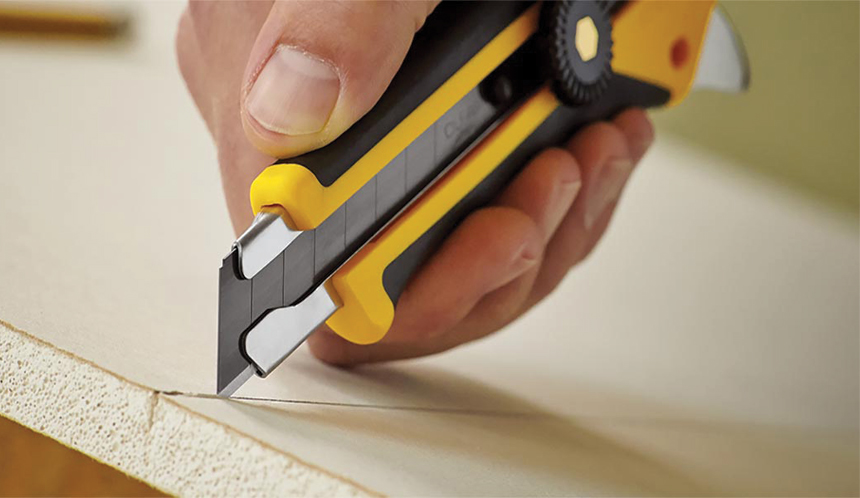
5 Utility Knife Care and Maintenance Tips
Utility knives are immensely common tools that are a staple for any toolbox. Regardless of whether you work in the industrial space or you’re a do-it-yourself (DIY) hobbyist, the utility knife’s versatility will get the job done.
Now, it’s vital to keep your utility knives in peak condition so they can operate effectively. This requires diligence on your part. Granted, certain knife materials need more cleaning than others. First, let’s break down what a utility knife is, and take a look at five utility knife care and maintenance tips.
What Is a Utility Knife?
A utility knife is a tool that’s for general manual work purposes. These knives can cut a wide array of materials including plastic, corrugated packaging, vinyl flooring, rope, foam insulation, dried caulk, carpet, drywall, plastic sheeting, nylon window screens, and much more.
Additionally, utility knives boast a few different retraction options. There’s the manual retractable feature, which allows the user to lock the blade into two positions: exposed and retracted. The auto-retractable option releases the blade via slider. Utility knives like these are made with safety as a top priority.
Lastly, there’s the self-retracting feature. This means that the blade self-retracts when it loses contact with its cutting material. This is, by far, the safest retracting option, as it ensures that the blade is never overexposed.
As for blade materials, utility knife blades are usually composed of titanium, aluminum, carbon steel, zirconium oxide, wood, and stainless steel. The handles are typically made of plastic, aluminum, glass-filled nylon, and stainless steel.
Now, let’s dive into five utility knife care and maintenance tips to bear in mind after you purchase one.
General Cleaning
The quickest way to destroy a utility knife is to use it for something besides its intended purpose. This means that you shouldn’t utilize it for opening cans, twisting or subjecting it to side loads, as a screwdriver, a hammer, or a chisel. Essentially, don’t use your knife for anything that’s meant for a different tool.
So, by keeping the above in mind, you’ll ensure the longevity of your utility knife. Besides that, there are general cleaning tips you can implement. For example, always clean your blades by hand after use. Don’t put them in the dishwasher or leave them to soak overnight.
Then, be sure to rinse them off with water and use a little soap on the blade only if there’s a bit of stubborn debris on it. Use a completely absorbent towel to dry your knife. Paper towels are excellent for this.
Knife Storage
You always want to store your utility knives in a cool and dry place. Make sure you store them separately from your other tools. If you have fixed blade knives with a sheath, it’s good to store them outside of the said sheath. Moisture can rust blades.
However, if you buy a utility knife with a blade that’s made of zirconium oxide, rusting won’t be an issue. Zirconium oxide is an advanced ceramic with a toughness that surpasses steel. In addition, it’s chemically inert, so the blade will never rust.

Cleaning Other Mechanisms
If your utility knife has locks and a pivot, you should periodically clean them with a light oil. Always make sure that you apply oil after your knife is totally dry. Consider investing in a folding utility knife if the folding aspect is appealing to you.
Better yet, one with a simpler design and less of the “bells and whistles” you’d see on a typical utility knife. A quick-release lock button is always a great feature to have on a folding utility knife. The less extraneous mechanisms you have to clean, the better.
Sharpen Your Knife
Your knives should stay sharp. Sharp knives are more effective and require less effort to cut, which helps prevent the risk of potential injuries. You can use a knife sharpener or sharpening steel. Never utilize a power-driven grinding wheel, as it can burn the temper from the blade.
While the above is critical for most utility knife blades, if you buy a knife with a zirconium oxide blade, you won’t need to worry about frequent sharpening. Zirconium oxide is extremely hard in comparison to standard steel.
This means that your sharp edge will last much longer than the aforementioned steel. Less time spent sharpening means less chances for accidents.
Handle Maintenance
If your utility knife has a wooden handle, you can employ the use of furniture polish or oil. Now, if your utility knife boasts a titanium or steel handle, you can usually just rinse with lukewarm water and a bit of soap, if necessary.
If you’re currently weighing your utility knife options, think about investing in one with a glass-filled nylon handle. It’s incredibly sturdy as well as comfortable to hold for long periods of time. Additionally, cleaning a nylon handle requires less frequent upkeep than other handle materials.
As long as you keep the above care and maintenance tips in mind when using your utility knife, you’ll be good to go. Of course, while considering the best knife for your needs, you should always research the latest in cutting-edge knife technology.




